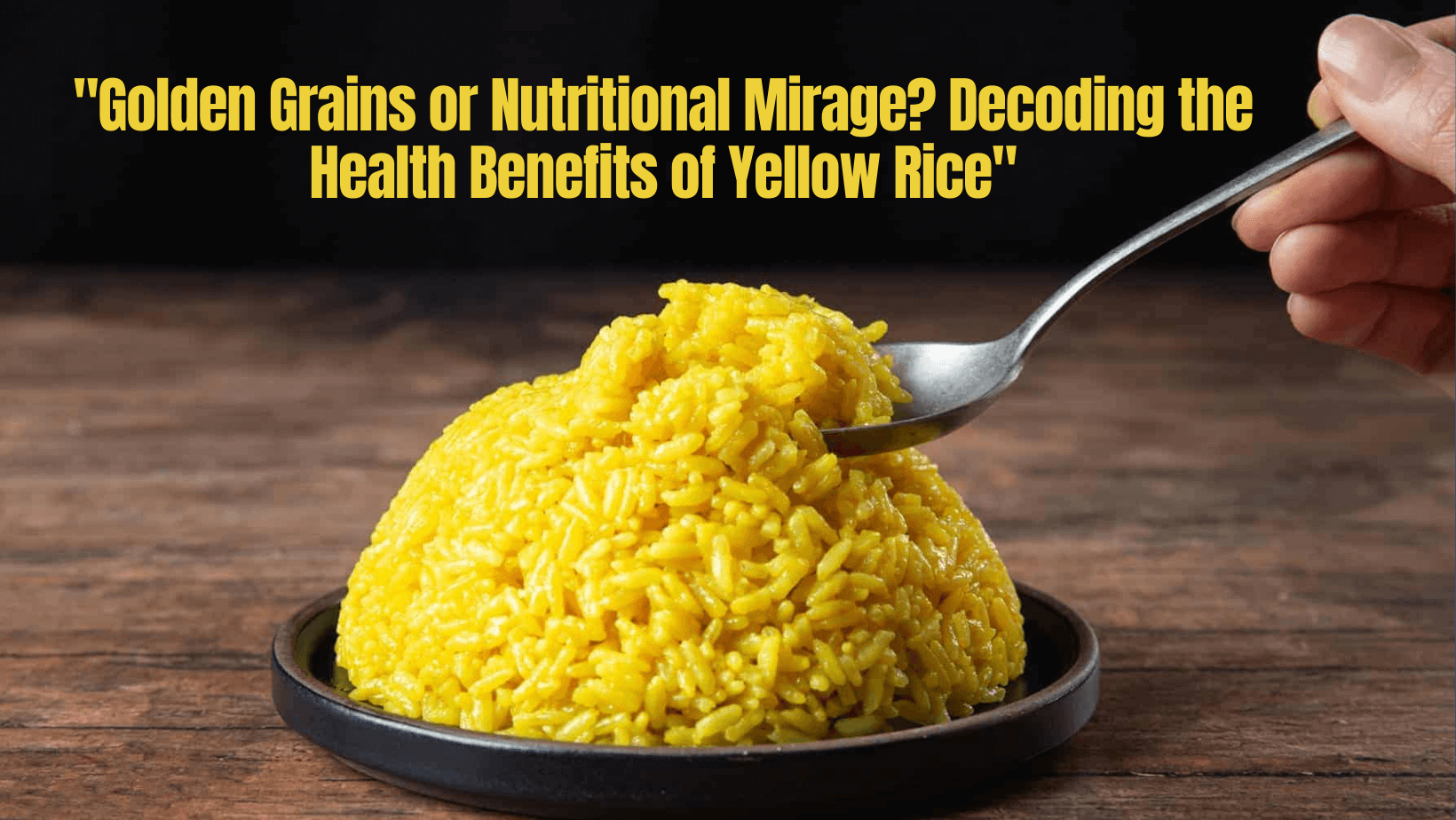
Yellow rice is an enticing and nutritious rice popular all over the world for its savory aroma and flavor. It is a white rice seasoned with turmeric and saffron to enhance its color, flavor, and aroma. Whether it is Spanish paella in Spain or biryani in India, it makes various cuisines more appealing with its presence. Yellow rice acts as a safeguard and protects you against potential heart risks. Yellow rice, full of carbohydrates, curcumin, vitamins, and minerals attracts us to explore its health aspects.
Nutritional Composition of Yellow Rice
Yellow rice contains various nutrients such as carbohydrates, proteins, fats, vitamins, and minerals. Let’s explore everything in detail.
Carbohydrate
One cup of cooked yellow rice offers 32.96 grams of carbohydrates. Carbohydrates found in yellow rice act as an essential energy source for the body. Yellow rice with its complex carbohydrates, maintains a consistent supply of energy over some time. This supply of energy supports the body’s functions and activities.
Proteins
It offers 6 grams of protein per cup. When it comes to protein content, lemon rice is not a high source of protein compared to animal products or legumes. But, it offers some plant-based proteins. Plant-based protein improves cholesterol levels and keeps your heart healthy. It is known for its environmental sustainability. Also, it controls your weight and prevents you from chronic diseases. It maintains bowel regularity and improves your gut health.
Fats
One glass of yellow rice offers you 0.27 grams of fat which is low. This fat contains omega-6 fatty acids which are known for their pro-inflammatory properties. If you add it to your diet in high amounts it can lead to health issues.
Vitamin B
Thiamine (B1): Vital for the functioning of the nervous system. Aids in breaking down carbohydrates.
Riboflavin (B2): Keep your skin, eyes, and nervous system healthy. Helps in energy production.
Niacin (B3): Maintains cholesterol level and supports energy production.
Vitamin B6: Crucial for the metabolism of proteins and other nutrients. Supports brain development, and improves the immune system.
Folate(Vitamine B-9): Assists in DNA synthesis. Vital for red blood cell formation and healthy cell division.
Vitamin A
If there is carrot, and bell peppers in yellow rice, it may offer vitamin A. It improves the immune system. Also, it is crucial for proper vision and cell growth.
Minerals
Magnesium: Yellow rice provides magnesium. It keeps nerve and muscle function healthy and enhances the immune system. 100 grams of yellow rice offers 112 mg of magnesium.
Iron: Iron content present in yellow rice Produces red blood cells and transports oxygen throughout the body. 100 grams of yellow rice offers 2.5 mg of magnesium.
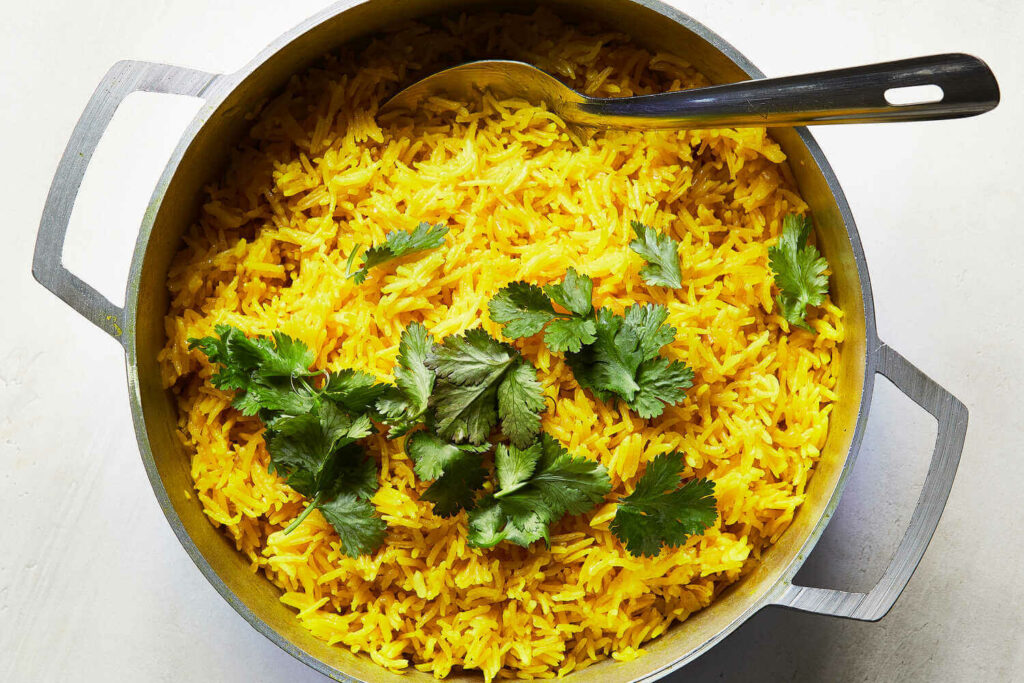
Curcumin in Turmeric
Turmeric is a type of spice obtained from the root of the Curcuma longa plant. Turmeric gives a yellow color to yellow rice and enhances its appearance. Also, it contains curcumin which contributes to potential health benefits.
How Does Curcumin in Turmeric Help You?
Anti-Inflammatory effects: Curcumin reduces/prevents inflammation in the body. Reduced inflammation prevents heart disease, cancer, and neurodegenerative disorders. Also, It reduces joint pain and takes care of your heart.
Antioxidant Activity: Curcumin Serves as an Antioxidant and neutralizes free radicals in the body. It protects you from cellular damage. Also, it prevents oxidative stress.
Brain Health: It may support your brain health. It prevents you from neurodegenerative diseases like Alzheimer’s.
Heart Health: It improves the lining of blood vessels and offers you cardiovascular benefits.
Concerns & Considerations
Bioavailability: Our body does not absorb curcumin properly due to its nature of low bioavailability. To enhance absorption, consume black pepper with turmeric. Black pepper is a good option for improving curcumin absorption as it contains piperine.
Pregnancy: Curcumin stimulates the uterus and causes complications during pregnancy. So, It’s better to have it in moderation or consult a doctor before having curcumin in high amounts.
Allergies: If you are allergic to curcumin then you should not have it.
High Dosage of Curcumin: Taking curcumin in moderate amounts is better as it may have side effects.
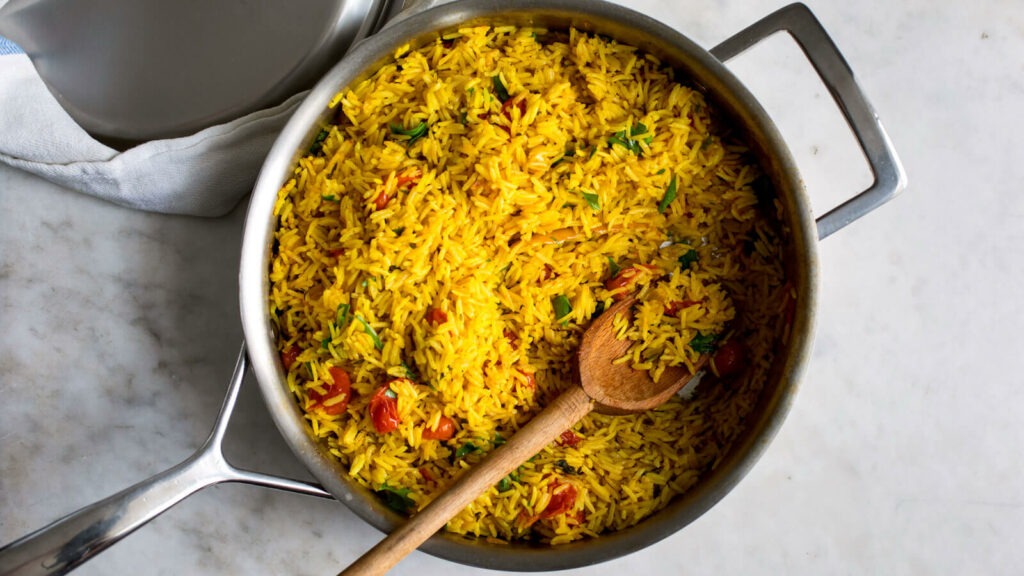
Impact on Blood Sugar
The glycemic index (GI) of Yellow rice is High because it is often made out of white rice. White rice elevates blood pressure due to its conversion into glucose during digestion.
This is how it increases blood sugar levels which is not good for people with diabetes.
Insights for Individuals With Diabetes or Monitoring Blood Sugar
- A person with diabetes should be cautious about portion size. Portion control may balance blood sugar levels.
- To slow down the absorption of glucose, pair yellow rice with protein and fiber-rich vegetables.
- Opt for rice with lower GI like brown rice or whole grain as it offers more sustained energy and does not affect blood sugar levels negatively.
Possible Additives and Preservatives
To enhance the flavor, color, and shelf life of yellow rice, manufacturers add various additives and preservatives to it. These preservatives may contribute to health issues. Let’s go through those preservatives and the potential health issues associated with them.
Flavor Enhancers: Monosodium glutamate (MSG) found in commercially available yellow rice enhances the taste. It may cause headaches, and nausea in sensitive individuals.
Artificial Coloring: Artificial Coloring contributes to hyperactivity in kids.
Preservatives: BHA (butylated hydroxyanisole) or BHT (butylated hydroxytoluene) are preservatives that extend the shelf life of yellow rice. The small amount of this preservative does not affect your health. There is research going on on its long-term impacts.
Stabilizers and Emulsifiers: While this retains the texture of rice, it may cause digestive issues in individuals with sensitivities.

Why is Natural Homemade Yellow Rice a Healthy Option?
Preservative and additive-free Homemade yellow rice is always a healthy option compared to artificial one. It allows you to add turmeric to enhance it by giving it a yellow color. You can pair rice with various vegetables and herbs to give a flavor of your choice. Instead of white rice, you can choose whole grain or brown rice as it regulates your blood sugar level and keeps you healthy.
Dietary Considerations
From vegetarian, and vegan to gluten-free diets, you can incorporate yellow rice anywhere. White comes with various health benefits, consuming yellow rice in moderation is always a healthy choice to keep yourself maintained and fit.
How Does Yellow Rice Fit Into Different Dietary Patterns?
Yellow rice fits into different dietary patterns like vegetarian, vegan, and gluten-free diets. Let’s discuss it in detail.
Vegetarian
Yellow rice made out of rice and various spices serves as a vegetarian food option. You can combine it with plant-based protein sources such as tofu, and tempeh. legumes and beans to enhance their protein content. Also, you can add peppers, peas, carrots, or spinach to elevate its nutritional value and fit it into your vegetarian diet.
Vegan
Use plant-based broth and pair it up with yellow rice. Add tofu, legumes, or beans instead of adding animal-based protein. Use peas, carrots, or spinach to enhance its nutritional value.
Gluten-Free Diet
Rice is a gluten-free food option. Use gluten-free additional ingredients. Instead of rice, you can opt for gluten-free grains like quinoa or millet to make yellow rice.
Alternative for Specific Dietary Needs—
Low-carb Version
If you are on a low-carb diet then opt for cauliflower rice or have yellow rice in small portion sizes.
Reduced Sodium
Use the salt in rice in low quantities and cook low-sodium broth to fit into a low-sodium diet.
Balanced Diet
Yellow rice plays a role in balancing your diet. It provides sustained energy as it contains complex carbohydrates. It is a nutritious food option that offers several health benefits through its spices. You get vitamins, minerals and essential amino acids due to the presence of vegetables in yellow rice.
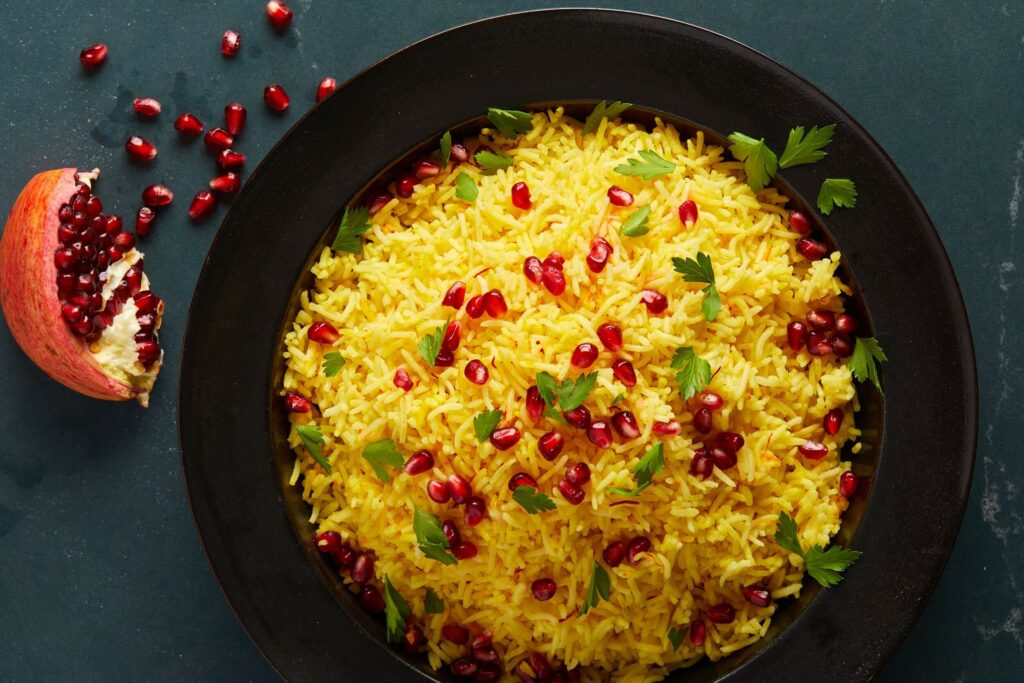
Culinary Uses & Recipes
You can combine yellow rice with various ingredients and get different health benefits and flavors from added ingredients.
Various Ways of Using Yellow Rice in Cuisines Globally—
Arroz Con Pollo (Latin America)
Arroz con pollo is a dish where the chef cooks yellow rice with chicken, bell peppers, tomatoes, and various spices.
Biryani (India)
Cooking biryani involves infusing yellow rice with marinated meat like chicken, mutton, or beef and various spices.
Paella (Spain)
Paella is a classic Spanish dish made out of yellow rice, saffron, chicken, seafood, and vegetables.
Nasi Kunning
Nasi Kunning involves cooking yellow rice with shallot, garlic, lemongrass, and coconut milk.
Healthy Yellow Rice Recipes
Vegetarian Turmeric Chickpea Bowl: First, prepare yellow rice and saute chickpeas then cook it with cumin, turmeric, and paprika. Mix it with sauteed vegetables and garnish it with cherry tomatoes and a sprinkle of fresh cilantro.
Grilled Turmeric Chicken With Yellow Rice: Marinate chicken with turmeric, garlic, and lemon. Grill the chicken and serve grilled chicken on top of a portion of yellow rice with grilled vegetables. Adjust the amount of spices or seasoning according to your taste.
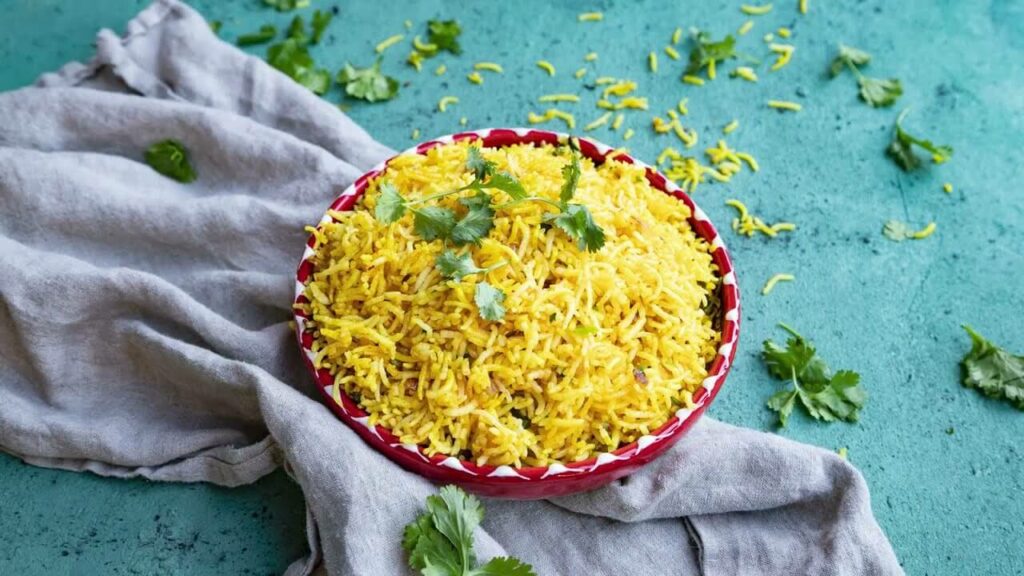
Nutritious Pairing Tips
Lean Protein: Combine it with lean protein such as grilled chicken, tofu, or beans to enhance protein content.
Leafy greens: Pair it with spinach, kale, or Swiss chard for iron and calcium content.
Colorful vegetables: Incorporate different vegetables for diverse vitamins and minerals.
Healthy fats: Use avocado, olive oil, or nuts for heart-healthy fats.
Frequently Asked Questions
Yes. consuming yellow rice in moderation offers you various potential health benefits. It offers you energy, enhances your immune system, and protects you against chronic diseases.
Yes, a moderate amount of yellow rice can be part of a balanced diet.
Yes, it is gluten-free.